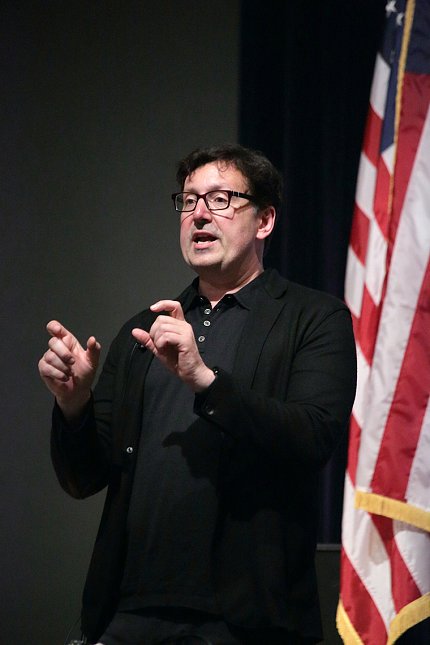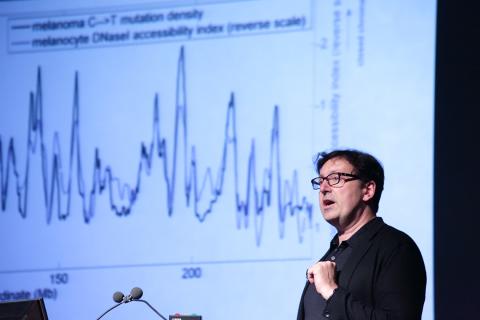Science Gets Closer to Clarity On Genome

Photo: Bill Branson
It appears that the actors that regulate the function of DNA in humans—and everything else that lives—behave much like human society: friends talk to friends, where you come from matters, family is important and memory is crucial—no one forgets their roots. It is a world where being turned on, and turned off, is the only thing that matters. Could DNA regulation be a metaphor for Saturday night on U St., or browsing on Tinder?
Such mysteries were plumbed at depth by Dr. John Stamatoyannopoulos, professor of genome sciences and medicine at the University of Washington School of Medicine and director of the Altius Institute for Biomedical Sciences, who spoke recently at the Wednesday Afternoon Lecture Series. Undeterred by the seeming impossibility of the task before him, he offered both the history of, and predictions about, the field in medicine that currently holds most hope—and most technological horsepower: the genome.
When the Human Genome Project announced success in the early 2000s, the real work had only just begun. Sure, we’ve got the letters, but what do they mean? How does the parts manual stand up and breathe?
Stamatoyannopoulos walked the audience through a timeline starting in the mid-1970s, when the link between chromatin structure and gene activation was established. That led to the development of DNA and RNA detection techniques, sometimes known as “footprinting.”
By around 1980, science discovered that native regulatory elements are marked by altered chromatin structure. For the next two decades, investigators discovered and mapped about 300 human regulatory elements.
“Then there came a burst of activity with genome-scale technology,” said Stamatoyannopoulos. Projects like NHGRI’s ENCODE and the Roadmap Epigenomics Program flooded public databases with an enormous amount of information involving more than 500 cell and tissue types.
A single cell, it turns out, activates some 150,000 regulatory elements, or about 1 percent of the human genome.
It is now appreciated that there are about 60,000 genes in the human genome, Stamatoyannopoulos said, including around 21,000 traditional genes that code for proteins, 40,000 non-coding genes and about 1 million non-coding RNAs.
As of 2016, more than 3 million regulatory regions have been discovered and more than 15 million transcription factor recognition elements have been found.
Categorizing that information is, however, “enormously complicated. It’s like we’re staring at this big forest, with no clear path forward…We are talking about millions of [regulatory] elements times thousands of cell states.”
Nonetheless, generalizations are emerging from this mass of information, including that cells, as they go from primitive to definitive states, appear to remember where they came from.
Also, for many common diseases, disease- and trait-associated variants are now known to be concentrated in regulatory DNA. This finding helps scientists interpret the significance of disease-associated variants that, prior to this, had no clear functional role, i.e., they were not in a promoter or a gene or anything obvious.

Photo: Bill Branson
In cancer, it has been found that cells reactivate primitive developmental programs. “Old stuff gets flipped on in haphazard ways,” said Stamatoyannopoulos. “We can now figure out the cell of origin of cancer.”
This is the fruit, he said, of the transition from a few maps to “lots and lots of maps” over the past 5-7 years.
Stamatoyannopoulos believes that, within 5 years, we will know where all the regulatory DNA is in the human genome. “I think we will have more than 90 percent of human regulatory DNA mapped by 2020,” he said. Within the same timeframe, about half of that regulatory DNA will be associated with its target gene, he predicted.
By the early 2020s, Stamatoyannopoulos envisions science’s ability to begin completing the important trifecta—from discovery, to detection to clinical translation.
The full lecture is archived at https://videocast.nih.gov/summary.asp?Live=19267&bhcp=1.
